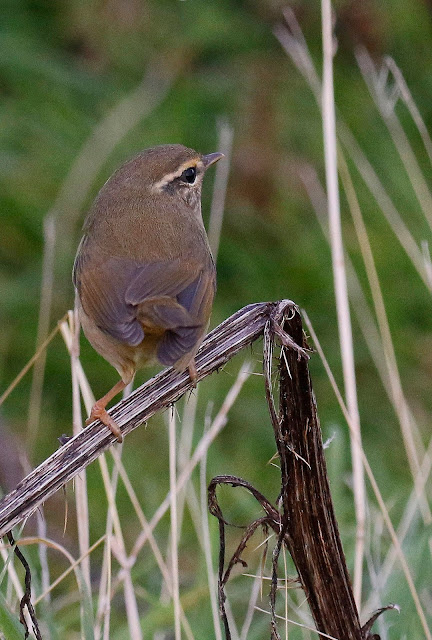A lovely sunrise over the island of Mousa heralded a day of sunshine with little wind. A hundred plus flock of Golden Plover stood in the sunshine on a hillside slope, curlews called in the clear air and a very grey looking Mealy Redpoll perched for a few seconds on a nearby bush.
 |
| The sun rising over Mousa |
News then came through of yet another Lanceolated Warbler being found on Unst and we decided to make another two ferry journey to distant Unst. Frustratingly our hopes were dashed as, when we got there, it turned out to have been a misidentified Grasshopper Warbler.
Shrugging off the disappointment we spent some time revisiting Norwick Beach and Valyie but news of a very showy Radde's Warbler at Sullom on Mainland persuaded Mark to get onto Shetland Inter Island Ferries to book us onto the earliest ferry possible back to Yell and then onwards to Mainland. Two birding colleagues who were with us, Chris and Gary, were also keen to go especially as the Radde's Warbler would be a lifer for Chris.They also had precise directions where to find the Radde's so we arranged to follow them.
We did not hang about as time was moving on and we only had a few hours of daylight left and 'The Yell Dash' was possibly covered in record time.Sullom is reasonably near where the Yell to Mainland ferry docks at Toft but required another fast but very cirquitous drive around Sullom Voe and then up a side road to Sullom. We came to a halt in a deserted farmyard where we left the vehicles and prepared to follow a metalled track a quarter of a mile out across moorland to where the Radde's had been found.
The discovery of the Radde's Warbler was by accident when a birder looking for a reported Red Grouse flushed it from a largish nettle patch. This kind of thing often happens on Shetland as birds can be found in all sorts of unlikely and unsuspected places wherever there is cover, even if it is minimal and not obviously suitable. Iris beds and nettle patches should therefore never be ignored.
We took the narrow track from the farmyard and half way along met three returning birders
'Is it showing'? we enquired.
'Yes but good luck, we have only seen it flying and then the views were brief.''
Not really the answer we wanted but we pressed on regardless.
The discouraging news was worrying as earlier reports had said the warbler was showing well. Radde's Warblers are arch skulkers and along with the closely similar Dusky Warbler are the devil's own job to see well and for relatively extended periods in the open (i.e seconds). The fact this bird was so showy was one of the reasons for us going to see it. It looked like we might be disappointed.
The nettle patch, located on a small mound just off the track was about the only cover on the surrounding moorland with the adjacent Sullom Voe shining grey and blue in the late afternoon sun and the oil terminal a distant eyesore at the head of the voe.
We were surprised to find only one other birder, a local, when we got to the nettle patch. Although Radde's Warbler is no longer considered very rare and is now classed by the BBRC (British Birds Rarities Committee) as a scarce migrant with around fourteen discovered each year in Britain, mainly in autumn. In my opinion it was still well worth the effort to see as I have only ever seen one before in Britain, at Kilminning in Fife in October 2012 and that was just for an all too brief few seconds.
They are well off course when found in Britain. Their breeding areas are in the taiga and steppe forest zones of central and eastern Siberia extending east to Korea and Manchuria where they inhabit thickets in open deciduous woods and forest edges, often near water and migrate to spend the winter in the south eastern Asian countries of Bangladesh, Cambodia, Laos, Burma and Thailand. Maybe the fact it is not a 'big' rarity anymore, the comparative remoteness of Sullom and the fact it was relatively far north on Mainland acted as a deterrent to others
The local birder told us he had seen the Radde's but only very briefly and it was proving very difficult to pin down its precise location in the nettles
Oh dear. It looked like we too would have to settle for brief views of it but first we had to find it in the nettles. Locating a small brown and buff bird that likes nothing better than to spend most of its time on the ground, hidden in this case in a fairly extensive patch of nettles would prove no easy task.The local birder directed us to the far side of the nettle patch as that was where he had last seen it.
Then our luck changed, as on walking around the outside of the patch we again flushed the warbler which rather than diving into another part of the nettles flew a few metres and perched openly on some dead thistles and grass adjacent to the nettle patch. Even more fortuitously it remained perched there, flicking its tail and wings in nervous tension, for at least a couple of minutes before hopping to another dead thistle and then flying off further.
 |
| c Mark |









No comments:
Post a Comment